What is
Otafuku Pearl?
・Receive a complimentary SV Otafuku charm
with every purchase.
SHINKAWA delivers carefully selected products, with our customers in mind,
to create a chain of smiles and pass them on to the future.

Where did it come from the name?
Named after the legend of Okame, famous for its Otafuku dolls Since ancient times, fat and happy women have been considered to ward off misfortune. Pearls are used for names that have legends that should be handed down in Japan, such as the Okame legend, which is handed down in Kyoto Senbon Shakado, and the attitude of caring for others. It is said that the otafuku doll's physique and smile are a manifestation of its desire to deliver a lot of good fortune to everyone. We also want to convey smiles and many blessings to our customers through jewelry.
Otafuku Pearl
Accessories made with traditional crafts using pearls and seashells as the main materials-jewelry products, Japanese Akoya pearl products, and original Otafuku charms and logos. The material used is silver K18 and precious metals such as platinum.
The theme of the work is the Seto Inland Sea, Miyajima, Hiroshima, etc.
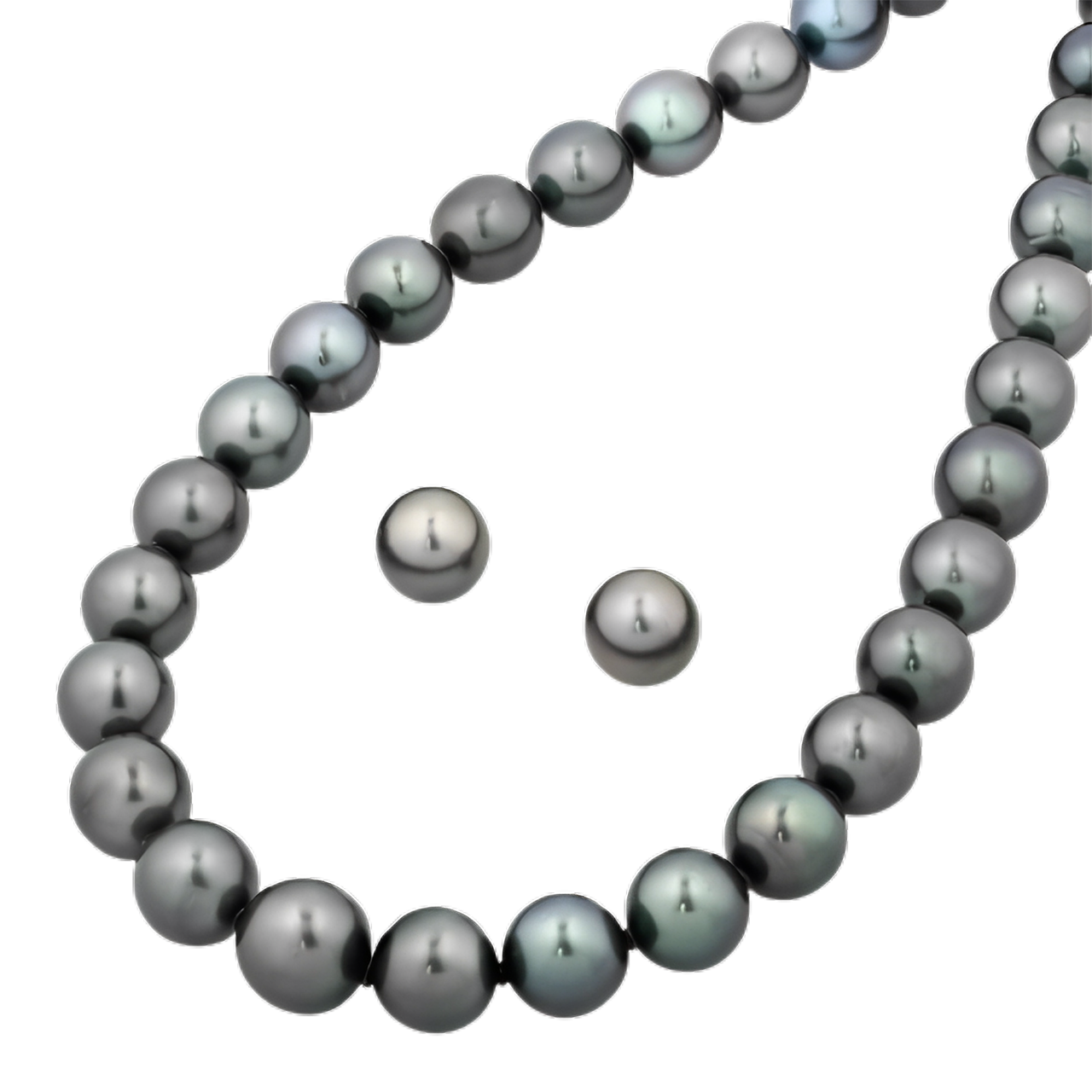

What is Makie?
This technique involves drawing pictures or patterns with lacquer on the surface to be decorated, then sprinkling metal or colored powder onto the wet lacquer to adhere it, and finally hardening it. It is a traditional Japanese craft unique to Japan and is said to have originated in the Nara period.
We have ensured thorough drying and have been manufacturing and selling our products since 2017. To date, we have not received any reports of skin irritation or rashes. However, as individual reactions may vary depending on direct skin contact with certain items, please do not hesitate to contact us with any concerns.
What is Raden?
A decoration method in which small shell pieces are attached to a vessel, wooden base, or lacquered surface.

7 Great Bonus

Fortune
beside you

Necklace
length adjustment

Accessories
All of the above pearl products come with a certificate of authenticity, a cleaning cloth, a paulownia box, and an instruction manual.
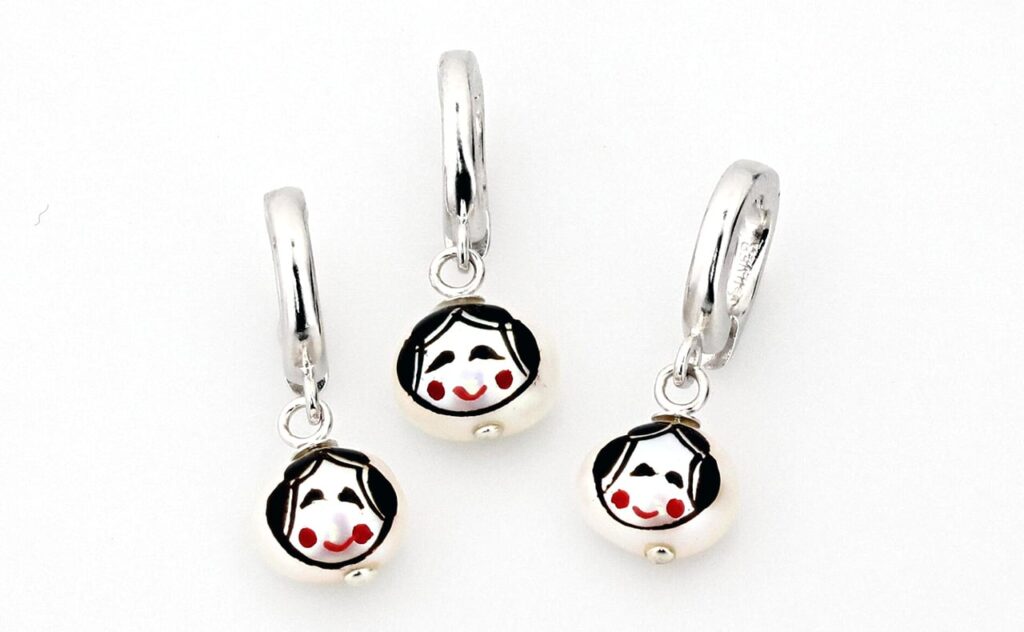
Otafuku
original top
For the Akoya pearl special necklace, a pendant top with Otafuku makie and a clicker gift
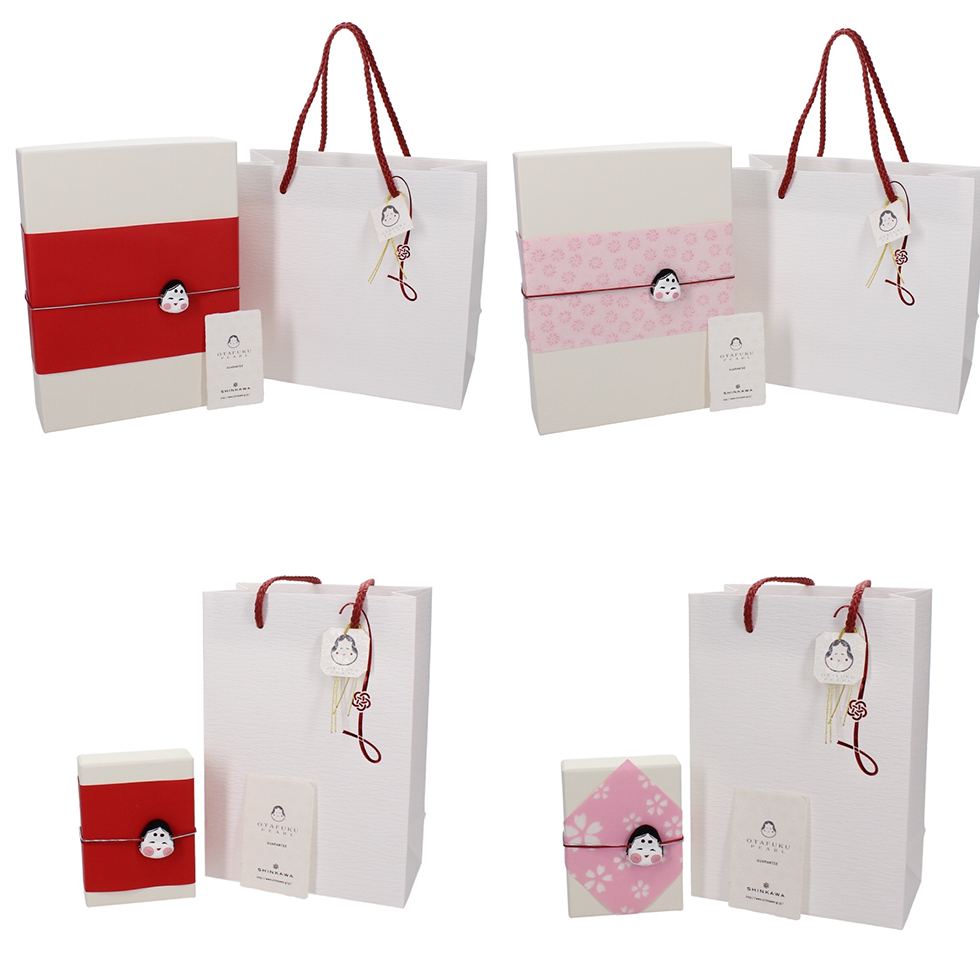
Otafuku
original packaging
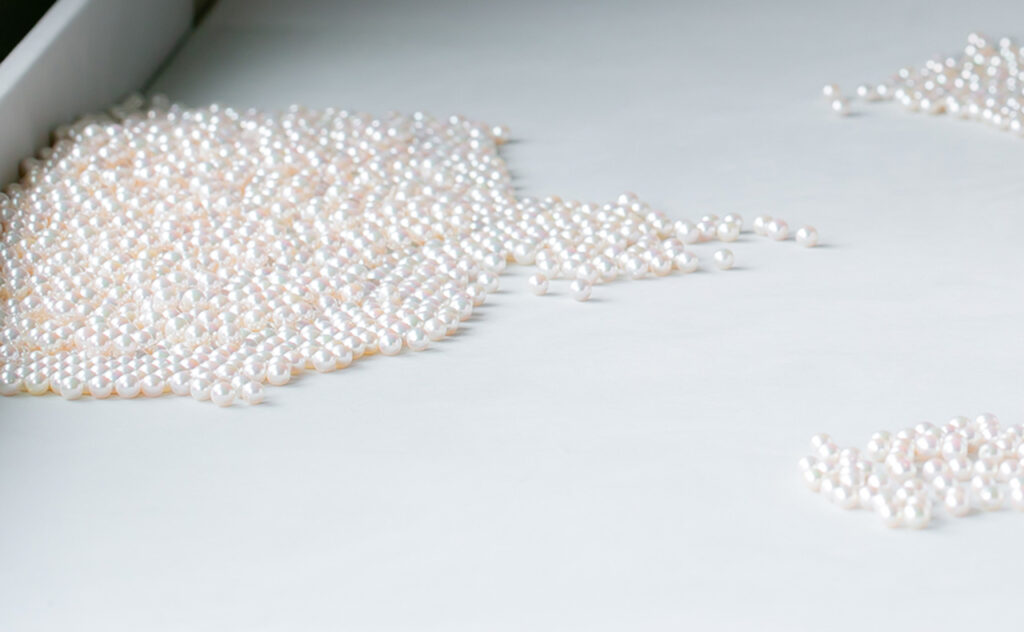
Long-lasting
free replacement of necklaces
(only in Japan)
If you have purchased a formal size pearl necklace, we will replace it free of charge for many years.

Simple cleaning
free for many years
Simple cleaning of pearl necklaces purchased at our company is available free of charge for many years if it is a formal size. Except for cleaning that requires replacement.
Pearl
Pearl stone word "Health, Purity, Longevity, Wealth"
One of June's birthstones
Pearl type
Akoya cultured Pearl
Also called Japanese pearls and Akoya pearls
Pearls that are cultivated mainly in Japan are made from Akoya oysters.
They are whitish to gold in color and spherical in size from 3 to 10 mm. A common pearl known in Japan, it has a finer luster than other pearls.


Black oyster pearl
Black , Tahitian Pearl
Polynesia, centered on Tahiti, is the main production area.
They are mainly black, but also include green, red, purple, brown, and other colors, with a size of 7 to 18 mm.
White oyster pearl
White clove
Australia, Indonesia, the Philippines, and Myanmar are the main production areas. Depending on the nacre layer inside the pearl, there are silver and gold colors, and the size is about 8 to 20 mm. Because the nacreous layer is thick, it is durable among pearls and is easy to use on a daily basis.


Freshwater pearls
China and Japan are the main production areas, and there are many sizes and shapes ranging from 2 to 15 mm or more. Colors include white, orange, and purple. It is on the market at a relatively reasonable price.
There are other types such as hemispherical mabe pearls, abalone pearls, and conch pearls.
How pearls are made
Until modern farming techniques were developed, pearls for jewelry were all natural pearls. A mollusc that can make pearls happened to take foreign objects such as pebbles into its body and covered them with its own mother-of-pearl layer to make them harmless. Until modern times, the Persian Gulf had a thriving natural pearl industry, but as farming technology was established in Japan, the main production area shifted to Japan, and it became the world’s top share. Behind this was the steady efforts of many people involved in the pearl industry, including technicians, producers, and processors.
Next, I will describe roughly how Akoya pearls are born.
First, young Akoya oysters are raised using artificial seedlings. It takes two to three years to grow to a size that allows the pearls to grow. In 2019, the main production areas of Akoya oysters, such as Ehime and Mie, suffered damage that most of the young oysters died due to environmental changes. It is the cause.

Moderately grown Akoya oysters are sorted out, and the oyster cleaning activity is slowed down for nucleus insertion surgery. It’s an anesthesia process for humans. It will hibernate for about a month.
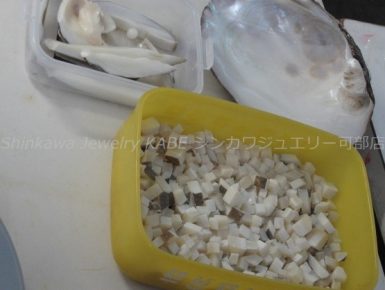
Inside the yellow container is a shell piece with a thick outer shell called a ditch shell. Using this as the nucleus, the mother-of-pearl is wrapped around the Akoya oyster. Assuming the size of the finished pearl, cut it into a ball.


Cut the mantle and dye it to make it easier to work with.
This round nucleus and a piece called a piece, which is cut from the mantle of the shell to about 3 mm, are put into the shell together. For pearls larger than 7mm, only one nucleus can be inserted into one oyster. This is because the load on the shellfish is increased. This nucleus insertion is human transplantation between living bodies, regenerative surgery. Skilled techniques are required, as the degree of adhesion between the core and pieces and the need for quick work are required.
After the nucleus insertion surgery, the wound is cured for about a month in a place with weak currents. It’s a period of rehabilitation. It is necessary to prevent oysters from dying and to improve the quality of pearls.
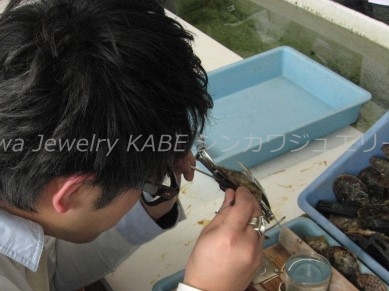

They are then moved to fishing grounds where food is plentiful and the shellfish are active. For 1 to 2 years, the oysters are raised regularly and cared for, such as by cleaning the shells.
We work carefully to remove barnacles and oysters attached to the shellfish. Organisms such as lugworms that invade the inside of shells are exterminated by immersing them in highly concentrated salt water. While doing this kind of work, we wait for beaching from late autumn to winter.
In winter, when the water temperature is low, the conditions are perfect for the luster of the pearls to improve, so it’s time to harvest.


In practice, the pearls are recovered by placing them in a mixer that does not damage the pearls.
After that, (1) sorting, (2) perforating, (3) pretreatment (the process of putting the pearls in alcohol to fix the organic ingredients, which is the process of tanning leather), (4) bleaching (the process of removing dark stains, etc., which is the original pearl) 5) Toning, 6) Polishing, 7) Reaming, and 8) Threads are put on the market. Compared to mineral gemstones, which are mined, sorted, cut and, if necessary, enhanced, pearls require far more manpower and effort to reach the market.

How to choose pearls
A pearl necklace is a must-have item because as you grow up, you will naturally have more opportunities to attend formal occasions. It is safe to prepare so that you do not panic in case of emergency. At that time, be sure to compare multiple pearls before purchasing. Considering that it will be used for many years, the recommended color is white pink. If the pink color is too strong, it will become difficult to match with your skin color as you get older. And those with thick rolls are less likely to deteriorate over time. Let’s check the size, shape, continuous phase condition, etc.
Teri (luster)
This is a very important factor in selecting pearls. It refers to the interference of light on the surface of the pearl, and it looks beautiful when the nacreous layers are stacked in an orderly manner. Basically, a beautiful luster can only be produced from a healthy mother pearl oyster. The thickness of the nacreous layer is also related to the thickness of the nacreous layer, but a thicker roll does not necessarily mean better teri. It is easy to see this by comparing pearls with other pearls.

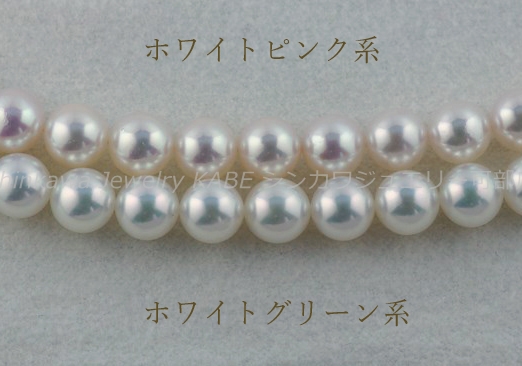
Colors
Mostly white, with some pink and yellow tones. Although pink is generally the most popular color, if the pink is too strong, it is not suitable for mourning and will mismatch with the color of the skin as the years go by.
Size
This is the most obvious point from a distance. Use different sizes depending on the occasion. For celebratory occasions, it should be large and gorgeous, while for mourning, it should be casual and respectful to those in attendance.

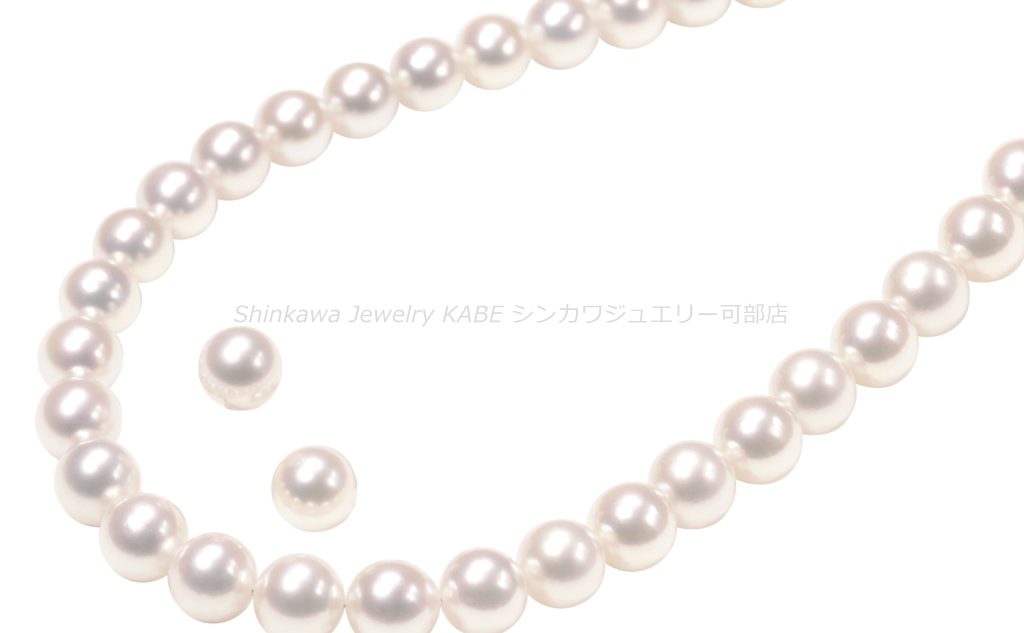
Roll and Shape
Roll is the actual thickness of the nacreous layer. In the case of Akoya pearls, a roll of 0.2 mm or less is called thinly wound and considered of inferior quality. The thicker the roll, the more durable it is. The closer the shape is to a perfect sphere, the better the quality.
Flaws
Flaws are surface irregularities that occur during the growth stage of pearls. Although it is rare to find pearls with no flaws at all, especially when viewed from a certain distance, such as in a necklace, they are not a concern unless they are large. Rather, the shape and the texture are more important.

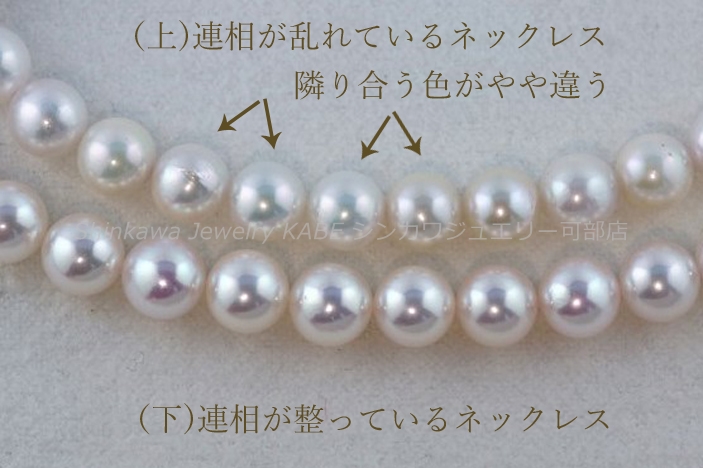
Chain of Pearls
In the case of a necklace with several pearls in a row, it is also important to note how well the pearls next to each other match in color and luster. A well-aligned chain gives a sense of unity and makes the necklace stand out even more.
Care for your pearls
The basic rule is “wipe and put away.
Pearls are sensitive to acidic substances and chemicals, so please finish applying makeup, etc. before wearing them and put them on last. Do not use spray cosmetics while wearing pearls.
After wearing, gently blow on the pearls with a soft, moisture-absorbent cloth as if rubbing them before putting them back on. If sweat or sebum is not wiped off, the pearls may lose their luster or look powdery when you look at them later. Please be sure to wipe them off.
Also, prolonged exposure to ultraviolet rays may cause yellowing. Do not leave the product near a window or under a fluorescent light.
Also, avoid places where there are sudden changes in temperature and humidity. Frequent expansion and contraction caused by moisture will damage the nacreous layer. Paulownia boxes are ideal for storage because they regulate humidity.
Pearls are generally considered to be weak jewelry. However, pearl products displayed in museums around the world are a good example, and with proper handling, pearls can retain their beauty for hundreds of years.
Pearl cleaning cloths, which we also use, are effective in the care of pearls.

Pearl cleaning cloth 660 yen (tax included)
This cloth is ideal for wiping pearls. Its outstanding water and oil absorbency allows you to remove oil and sweat from your hands and cosmetics from pearls. It can be washed and used many times.

Pearl refresh cloth 660 yen (tax included)
This cloth restores the luster of pearls. Over the years, when the surface layer of pearls develops minute, invisible irregularities, the luster of the pearls becomes dull. This cloth restores the original luster by flattening out the irregularities.
Be careful not to loosen a strand of pearl necklace. In the past, thread was used, so it needed to be rethreaded (thread replacement) periodically as it deteriorated over time. Nowadays, wire is used, so it does not deteriorate as much as thread, but depending on the condition of storage and care, the wire may rust, for example, if it is stored with perspiration on it. Check it from time to time.
Please feel free to contact us for more information on the care and handling of pearls and other jewelry.